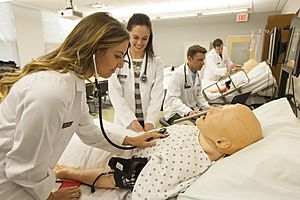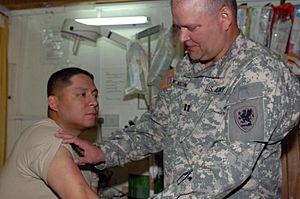Physician assistant facts for kids
A physician assistant (PA) is a special kind of healthcare provider. PAs work with doctors to help people stay healthy. They can figure out what's making someone sick, create plans to help them get better, and even prescribe medicines. In many places, PAs work closely with a physician.
PAs train in less time than a traditional medical degree. While extra training called residency is sometimes available, it's not usually required. This type of healthcare role first started during World War II. Back then, there was a shortage of doctors, so a faster way to train medical helpers was needed.
What PAs are Called
The name "physician assistant" began in the United States in 1967. In different countries, these healthcare professionals might have slightly different names.
| Country | Title | Short Name |
|---|---|---|
| United States | Physician Assistant | PA-C |
| Canada | Canadian Certified Physician Assistant | CCPA |
| United Kingdom | Physician Associate | PA-R |
| Republic of Ireland | Physician Associate | PA |
When a PA uses "PA-C", the "C" means "Certified". This shows they have passed a special exam. Students training to become PAs are often called "PA-S".
What Services PAs Provide
Physician assistants or associates can do many important things to help patients:
- They talk to patients and learn about their health history.
- They perform physical exams to check how a person's body is working.
- They can order and understand medical tests, like X-rays or blood tests.
- They figure out what illnesses a person might have.
- They create plans to help people get better.
- They help manage a patient's overall care.
- They can perform some medical procedures.
- They prescribe medications.
- They do research to find new ways to help people.
- They give advice to patients about their health.
- They teach people how to stay healthy and prevent sickness.
- They can even help doctors during surgery.
Where PAs Work
Physician assistants or associates work in many different places. You can find them in hospitals, clinics, and other health centers. They also work using telemedicine, which means helping patients remotely through technology.
PAs often work in teaching and research. They can also be found in hospital management. They might work in primary care, which is your regular doctor's office. Or they can specialize in areas like emergency medicine, surgery, or heart care.
How PAs are Trained
Training to become a physician assistant or associate is shorter than becoming a doctor. It usually doesn't include a long residency training period. However, some PAs do choose to get extra training in specific medical areas. To keep their certification, PAs usually need to renew it every few years.
History of PAs
The first group of physician assistants started training in 1965 at Duke University. This program was created by Eugene A. Stead. He based the training on how doctors were quickly trained during World War II. The first PA students were former US Navy medical helpers.
Over time, the PA profession grew and spread around the world. Today, you can find PAs helping people in many countries.
PAs Around the World
PAs in Australia
In 2011, Australia tried to introduce physician assistants. Even though it seemed like a good idea, most PAs in Australia have had trouble finding jobs.
PAs in Canada
Overview of PAs in Canada
As of 2018, about 800 physician assistants work in Canada. The first PAs in Canada graduated in 1984 from a military program. PAs can do many medical tasks, like ordering tests, diagnosing illnesses, prescribing medicines, and treating patients.
Training and Certification in Canada
The first civilian PA programs in Canada started in 2008. These programs are very competitive to get into. PA education in Canada usually takes about two years of full-time study at a university. After graduating, PAs must pass a certification exam to be able to work.
What PAs Do in Canada
Canadian PAs are like advanced medical providers. They work under a medical model, similar to how doctors are trained. This means they can work in almost all medical specialties. They can practice in emergency rooms, critical care, heart care, and many other areas. PAs can do many jobs that doctors traditionally did.
PA Salaries in Canada
PA salaries in Canada can vary. New PAs might earn around $80,000 CAD per year. Experienced PAs can earn about $105,000 CAD per year. Some experienced PAs who are on call can earn even more.
Rules for PAs in Canada
PAs have been working in the Canadian military since the 1960s. Outside the military, PAs work in public healthcare in some provinces like Manitoba and Ontario. In Manitoba and New Brunswick, PAs are officially regulated by their medical colleges. In other provinces, regulation is still being discussed.
PAs in Germany
In Germany, the Physician Assistant role is called Arztassistent. It was first introduced in 2007.
PAs in India
India started its first PA program in 1992. It focused on helping with heart surgery. Since then, more programs have started to train PAs in India.
PAs in Ireland
Physician Associates were introduced in Ireland in the mid-2010s. A university in Ireland has offered a PA degree since 2016. However, PAs in Ireland are not allowed to write prescriptions.
PAs in New Zealand
New Zealand tested the PA role from 2013 to 2015. PAs worked in emergency rooms and clinics. After the test, some clinics continued to hire PAs while the government works on official rules for them.
PAs in the United Kingdom
The job of physician associate started in the United Kingdom in 2005. It was inspired by the physician assistant role in the US.
Professional Body for PAs in the UK
The Faculty of Physician Associates is the main group for PAs in the UK. It helps set standards and runs the national exams for PAs.
What PAs Do in the UK
PAs in the UK are trained like doctors to provide medical care. They can work in many areas, including emergency medicine, surgery, and mental health. They perform tasks like diagnosing illnesses, taking medical histories, and doing medical procedures.
Training for PAs in the UK
Training to be a PA in the UK is usually a two-year university program. Many universities offer these programs. To get in, students often need a science-related degree and some healthcare experience.
PA Salaries in the UK
The starting salary for a PA in the UK is around £37,000. In London, it can be higher, around £43,000. With more experience, PAs can earn up to £50,000. PAs can also work extra shifts to earn more.
PAs in the United States
Rules for PAs in the US
In the United States, PAs must graduate from a special accredited program. They also need to pass a national exam to become certified. Each state has its own laws about what PAs can do, including prescribing medicines. PAs usually work with a doctor who oversees their practice.
Training and Certification in the US
As of 2019, there were over 240 accredited PA programs in the US. Most of these programs lead to a master's degree. They usually take 2 to 3 years of full-time study. PA training includes classroom learning and hands-on experience in different medical areas. After school, PAs must pass the Physician Assistant National Certifying Exam (PANCE). They also need to continue their education and re-certify every few years.
"National Physician Assistant Week" is celebrated every year in the US from October 6 to October 12. This week honors the first PA class that graduated in 1967.
Where PAs Work in the US
The US Department of Veterans Affairs is the largest employer of PAs, with nearly 2,000 PAs working there. As of 2020, there were more than 148,560 certified PAs in the United States.
The PA profession is often ranked as one of the best jobs in America. This is because there are many job openings and good salaries. The number of PA jobs is expected to grow very quickly in the coming years. This is partly because more people need healthcare and the population is getting older.
Most PAs work in doctors' offices or clinics. Others work in hospitals, public health clinics, nursing homes, and even prisons.
PA Salaries in the US
In 2020, the average pay for PAs working full-time was about $115,390 per year. Some PAs in certain specialties, like emergency medicine or surgery, can earn up to $200,000 per year.
PAs in the US Government and Military
PAs work for the United States Department of State in embassies around the world. They provide healthcare to US government employees and their families. They also advise ambassadors on health situations in other countries.
Military PAs serve in the White House Medical Unit, caring for the president and vice president. They also work in the United States Army, Air Force, Navy, and Coast Guard. These PAs get special training for military medical needs.
See also
 In Spanish: Asociado médico para niños
In Spanish: Asociado médico para niños



